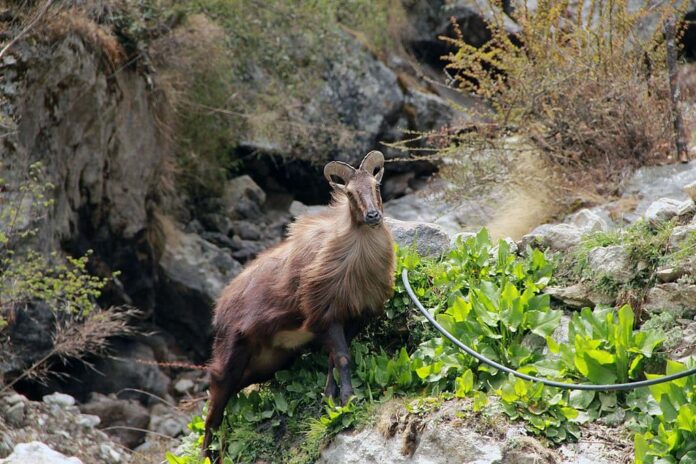Tahr (pronounced tar), is a goat-like mammal that is closely related to goats and sheep. There are 3 tahr species, and all of them are native to Asia though some were introduced to New Zealand. The tahr species are Arabian tahr, Himalayan tahr, and Nilgiri tahr. Not many people know about this unique animal, and we are going to discuss them today. Feel free to check out some of the interesting about tahrs below.
1Appearance

A tahr stands from 65 to 100 centimeters at shoulder height and weighs up to 136 kilograms. It has a small head with large eyes and small and pointy ears, and the legs are relatively short. One of the most standout features that tahrs have is in males, the mane of long hair around their neck and shoulders. After the spring molt, his coat will be shorter and lighter in color. Male tahr’s coat is reddish-brown while the female’s coat is medium brown in summer but both turn dark brown in winter.
Both sexes have triangular horns that curve upward, backward, and then inwards. The horns grow to a maximum length of 45 centimeters, and they are usually larger in males. That is not all, a mature male is 6 years old or older which you can count by the ring on his horns. Another important feature is their flexible hooves with a rubbery core that allows a smooth grip on rocks. The hooves have a hard and sharp rim that they can use to lodge into small footholds with ease. This is why tahrs can move confidently and quickly over rocky terrain.
2Behavior

Tahrs are social animals, and they form groups of 2 to 20 members that we can easily recognize. For Himalayan tahrs, they form mixed herds of 15 up to 80 individuals to migrate down the mountain in winter. Adult females hang out with yearlings and kids while males over 4 years old form their own bachelor groups. Then we have younger males of 5 years old or older that hang out together in smaller and separate groups. Males and females do mix together during winter which is the breeding season. However, adult males often travel long distances away from the female groups. They also have rut season which is from May to July. With people, they are very shy and wary, and they can run quite fast to flee when startled.
3Feeding & Habitats

Generally, tahrs feed in the morning and they spend hours doing it before resting and feeding again in the evening. Tahrs spend the middle of the day just resting among rocks and vegetation before dinner time approaches. These ungulates feed in the same location every day, and it is very easy to notice their daily routine. They usually graze on alpine herbs, snow tussocks, and sub-alpine shrubland plants. Along with that, tahrs also browse plants in high forested areas, and feed on shoots and tree leaves. They can rear up on their hind legs to reach tall branches and hold branches down with their forelegs while eating.
Tahrs are native to the Central Himalayan ranges across India and Nepal, mostly in the alpine grassland zone. Their distribution is more common in montane woodlands and rugged mountain country in the Himalayan mountains. Nepal gifted tahrs to New Zealand in 1904 for sport, and they are found in the Central Southern Alps. The Alps is between the Rakaia and Whitcombe valleys to Lake Hawea, with the main population around Mt Cook area.
4Predators & Threats

Snow leopards are their only natural predators, and people who live in the hills hunt them for meat. Accidental deaths due to avalanches or rock slides are also quite common. Other causes that threaten their population are competition from domesticated goats and sheep and habitat loss due to the expanding human population. What’s more? Military conflicts and overhunting also play a part in decreasing their number.
One of the main threats to their lives is hunting because tahrs are among the trophy animals. Tahrs are popular with international and recreational hunters for their horns and mane. Hunters can legally hunt them both on government land or private land in New Zealand because tahrs have become pests there. While their conversation status is considered Vulnerable on the IUCN Red List, tahr trophy hunting still continues. Tahr hunting is illegal in Nepal and there are many protected areas along the Himalayas where hunting them is illegal.
Related Post: Dangerous Goat Breeds To Stay Away From




